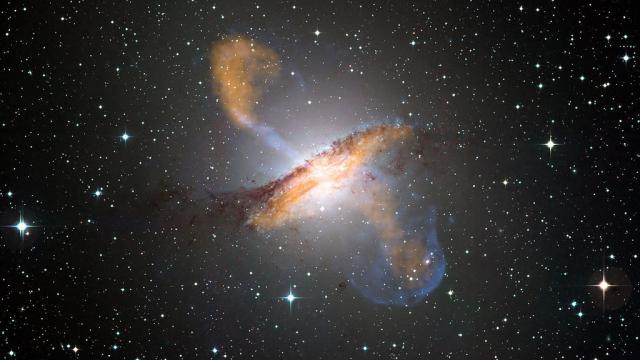If active galactic nuclei don’t make you say “holy crap”, what will? A lot of galaxies contain incredibly bright regions at their centre, spewing high-energy jets into the depths of space, brighter than the light the galaxy’s stars can produce.
Image: ESO/WFI (visible); MPIfR/ESO/APEX/A.Weiss et al. (microwave); NASA/CXC/CfA/R.Kraft et al. (X-ray)
But as bright as that light is, it isn’t the whole story — we only seem to see a fraction of the total energy as radiated light, for some reason. Since, probably fortunately, we don’t have an active galactic nucleus spewing a high-energy jet in own galaxy, understanding the mystery behind the missing energy requires 3D simulations. That’s what a team of scientists in the United States did, and they think they may have found an answer as to where the extra energy went.
“Whatever the process that triggers this electromagnetic radiation has to affect a significant portion of the jet’s energy budget,” Alexander Tchekhovskoy from the Theoretical Astrophysics Center at the University of California, Berkeley, told Gizmodo. Essentially, there’s something causing all of the particles beaming out of these galaxies’ central black holes to lose a lot of energy — energy that our telescopes see as light (in the form of quasars and blazars, for example).
Tchekhovskoy’s simulation modelled black holes forming these jets from the matter torn apart by their intense gravity. This causes jets of charged particles and their magnetic fields to shoot outwards into the medium surrounding the galaxy, according to the paper that will be published in the Monthly Notices of the Royal Astronomical Society.
The simulation lets the medium look one of two ways: Either it’s just a lot of ambient stuff, or it has a hole drilled into it from prior jets. Both options have an explanation for the missing energy. In the first case, the medium compresses the jet like trying to push a spring through honey, explained Tchekhovskoy. This causes the matter to kink aside and lose energy, which is radiated outwards as light. In the other case, the holes confine the spreading jets, and the matter at the jets’ sides knock inwards, creating shockwaves that could lead to the light beam exhaust.
“It’s not just one physical mechanism that would be responsible for emission in all these jets,” said Tchekhovskoy. “It could be one or the other, or the combination of the two, depending on what a black hole was doing previously.”
At least one other scientist thought the work certainly had merit and was a useful simulation. “The novelty is that the authors managed to follow the jet evolution from the beginning, when the jet is launched from the central black hole,” Eleonora Troja, Research Scientist at NASA Goddard Space Flight Center, told Gizmodo. She also pointed out that it offered good theoretical confirmation of some speculative ideas.
Like all models, it has its limitations. Troja and Tchekhovsky both noted that it needed to be scaled down and simplified a bit to accommodate current computing power. Furthermore, said Tchekhovskoy, not everything around the black hole could be perfectly simulated from scratch, so some of those pieces relied on previous models.
These astrophysical jets are still important for more than just crazy galaxies, said Troja. Collimated jets of matter are ubiquitous in our universe, from galaxies down to spinning neutron stars. “Yet we do not fully understand how they form and develop.”
[MNRAS]
